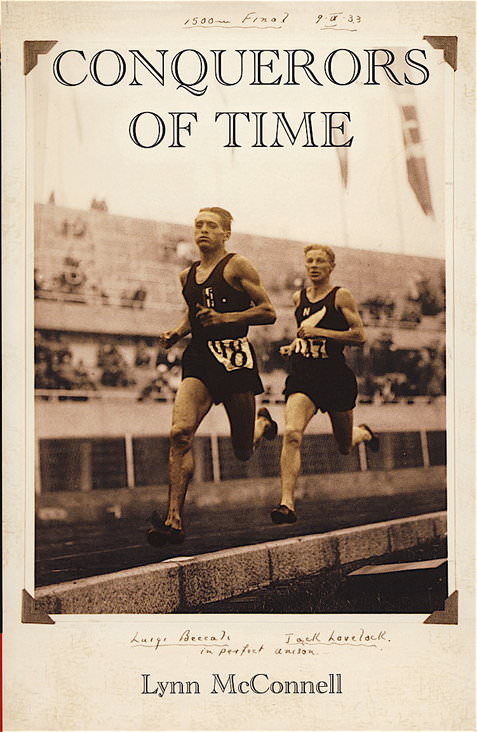Racing Past >> Book Reviews >> Conquerors of Time
Book Review
Conquerors of Time by Lynn McConnell. Sports Books, Cheltenham, UK, 2009. 239pp.
 |
It took me a while to get hold of this book, but I’m glad that I persevered. It’s now in my must-have collection. This highly researched book focuses on the 1,500 and covers the 1932 and 1936 Olympics and the years in between. Primarily the book is about Jack Lovelock, Luigi Beccali, Glenn Cunningham, and Bill Bonthron, the first three having run in both Olympics. There is also information about other great 1,500 runners of this 1932-1936 period: Sydney Wooderson, Gene Venzke, Phil Edwards, and Jerry Cornes. Wooderson and Venzke had one disappointing Olympics in 1936; Cornes and Edwards, however, medaled in one Olympics and placed in the top six in the other.
The structure of this book is well conceived. With the two Olympics as the book-ends, Lynn McConnell fills the middle with chapters on Lovelock, Beccali, Cunningham, Bonthron, Wooderson and Venzke, each chapter focusing on a race in which these main characters competed. The races between the two Olympics heighten the interest in the big race to come, the Berlin 1,500. Before we get to his thorough three-chapter coverage of the 1936 Berlin 1,500, we get excellent material on the immediate build-up to this extraordinary race that was held in front of Adolf Hitler. Finally, we get an interesting chapter on the lives of these athletes post-1936.
Being a New Zealander, McConnell not surprisingly focuses a little more on Jack Lovelock. But this does not detract from the book at all. After all, the climax of this story is the victory of Lovelock in Berlin! Lovelock’s running career, of course, has been well documented by Norman Harris (1964) and David Colquhoun (2008), but McConnell adds more, especially in his long chapter on Lovelock’s tactic in Berlin, “The Three-Hundred Metres Sprint.” Those who have already read Harris and Colquhoun won’t be disappointed.
There is a lot of original material on some of the other runners. McConnell, in researching this book, spent some time in the USA. He was in contact with the families Bonthron, Cunningham, Beccali (who settle in the USA) and Venzke. As they say, fascinating stuff.
McConnell is a well-known New Zealand journalist with 16 books to his credit. He has written on many sports, especially cricket and rugby. He is also a historian. Here is a sample of his writing as he assesses Jack Lovelock: “His revolutionary approach has been under-appreciated. He has been wrongly portrayed as nervous, indecisive and hard to get to know. He was committed, driven and inspired. He knew what he wanted and he ensured he didn’t deviate from that path. Perhaps that did make him difficult to understand, but then again, how many people would understand if he did open himself up to them? He was thinking on a different level from those around him. Whatever his personal characteristics may have been, there can be no doubting his methodology. He created a devastating tactic to win the most important race of his career.” (pp. 183-4)
Conquerors of Time is particularly valuable for it material on Beccali and Bonthron. Hitherto not much has been written about these two world-record holders. But I would have like more on British runner Jerry Cornes and on Canadian runner Phil Edwards. These two were prominent in both Olympic races.
Perhaps the gem of this book is the 14th of the 15 chapters, “The Three-Hundred Metres Sprint.” The 14 pages of this chapter explore in depth Lovelock’s psychological make-up and how he used his intellect to develop the tactic that won him an Olympic gold. McConnell writes, “While others would employ greater strengthening as the basis of their improvement to break the four-minute barrier and achieve other world-record times, Lovelock pitted this thought processes as the back-up to his undoubted running skills.” (p. 183) Good use is made of an essay Lovelock wrote in 1935, “Youth and Modern Sport.” In this essay Lovelock talks about temperament and claims that “mental stability” is “at the root of all athletic success.” McConnell uses this essay and other material to follow the evolution of Lovelock’s approach to Berlin. He argues that the 300 sprint that Lovelock used was just one of his options. All of these options, Lovelock told a young protégé before the race had to be “a surprise.”
Brilliantly conceived, thoroughly researched and elegantly written, this is one of the best running books I have read. In my view it is the seminal book on middle-distance running in the 1930s. Very highly recommended.
Note: The paperback version of this book is expensive and difficult to find, but it can now be obtained as a download.
http://www.racingpast.ca/reviews.php?id=24
No comments:
Post a Comment